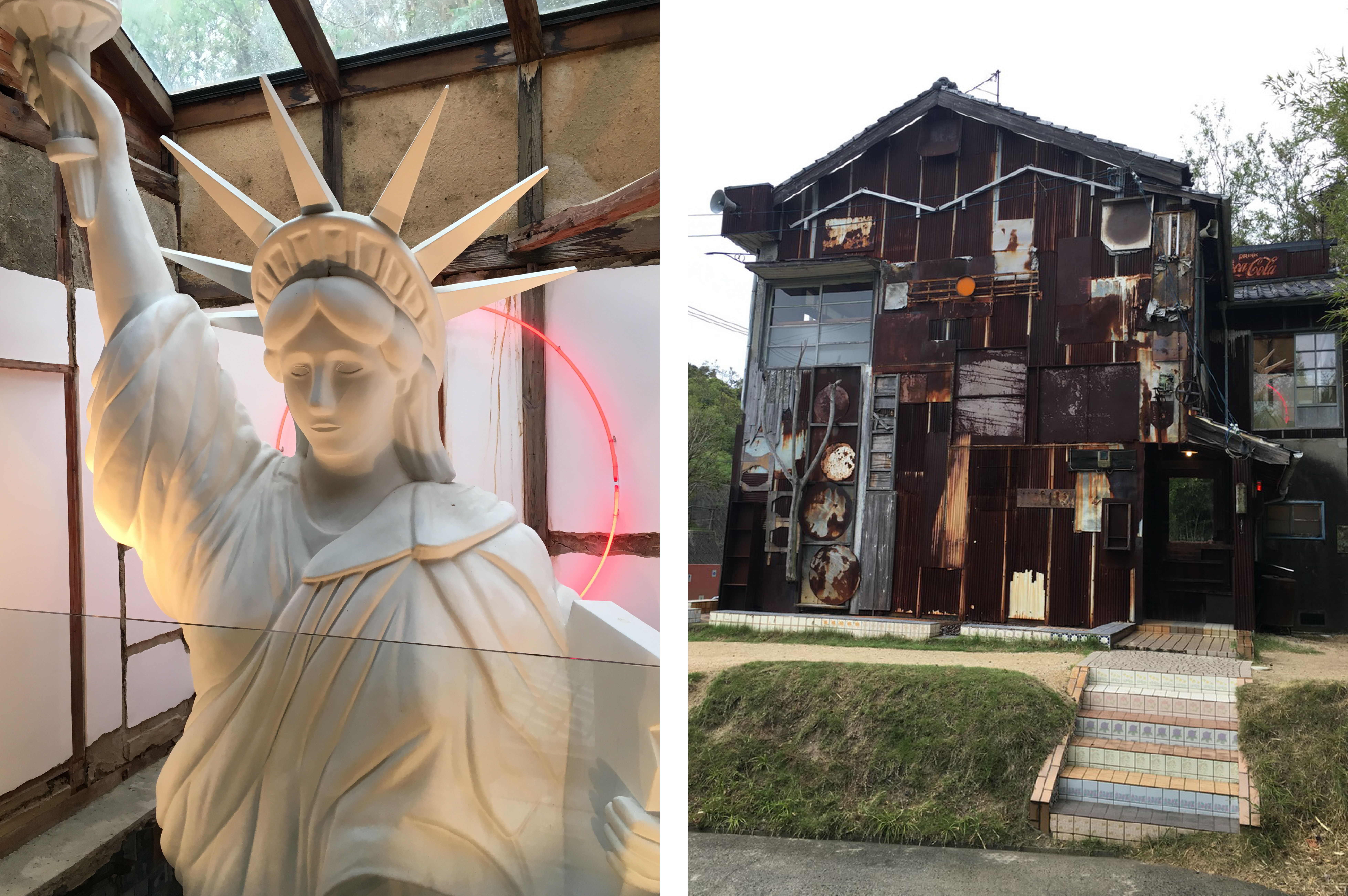
Deborah J. Cooper
FAIA, LEED AP BD+C
Principal
At the end of 2019, I went on a three-week tour of Japan led by Yoshiko Iwamoto Wada of Slow Fiber Studios in Berkeley. The tour focused on traditional shibori dying practices, and included plenty of architecture, ceramics, and other forms of art. A highlight of the trip was our time on the ‘art islands’ of the Seto Inland Sea. After a challenging 2020, what follows is an attempt to look outward once again to the beauty and wonder found all around us. I hope it brings you joy!

Art installation at Inujima (left) and bamboo structure on Shodoshima (right)
Once dependent on fishing and metal processing, Naoshima has transformed itself into a global arts destination. This began with Soichiro Fukutake, the billionaire heir of the education and publishing conglomerate Benesse Holdings, who had inherited a large piece of land on Naoshima and owned an extensive modern art collection. He hired Tadao Ando to design the Benesse House Museum, which is both a museum and a hotel. Ando went on to design more hotel/museums on the island, and soon the enterprise expanded to several other islands nearby, Shodoshima, Inujima and Teshima. Houses in the historic towns on each of the islands have been converted to art installations or “art houses,” each having their own character. It creates a wonderful, layered experience of traditional and contemporary architecture and art in a beautiful natural setting.

Les Archives du Coeur Building by Ando, Teshima
One of the memorable installations we visited was in a small house on the beach in Teshima, The work of French artist Christian Boltanski, it’s called Les Archives du Cœur, and it features the recorded heartbeats of people from all over the world. You walk into the main installation space, a dark room with photographs on the wall. The space is lit by only one lightbulb, which flickers in time to the recorded heartbeat of the person that’s playing. It’s very moving. There’s also a small room where you can record your own heartbeat to become part of the collection.

Teshima Art Museum
On the northeast edge of Teshima, Ryue Nishizawa, one of the founders of Tokyo-based architecture firm SANAA, designed the Teshima Art Museum. It’s not so much a museum as an artwork in itself. It consists of a blob-shaped concrete shell—in plan, it’s an amorphous circle—with a domed ceiling that has two openings in it. To enter the building, you travel through the woods down a path. Once you’re inside, the openings in the ceiling amplify sounds from the outside. Thin pieces of film hang from the ceiling and move in the breeze, and water droplets trickle up from below the floor and move across the floor. It’s a sublime work of art that showcases nature with the simplest gestures. I wish they allowed us to take photographs inside!
Along the harbor on the northwest edge of Teshima is the Teshima Yokoo House, a collaboration between the architect Yuko Nagayama and the artist Tadanori Yokoo. They renovated an old, private house into exhibition spaces that display water-themed artwork. A creek runs under the building, visible through a glass floor. The interior of the tall, cylindrical tower out back is lined with pictures of waterfalls, reflected by a mirrored floor so it looks like it goes on forever.

Yokoo House
On Naoshima, we visited Haisha, an old dentist’s house renovated by artist Shinro Ohtake. Ohtake went wild with this house, inside and out, collaging found objects, photographs, mosaics, and other materials to produce a scrapbook aesthetic. The floor is littered with photos under glass. There’s a two-story Statue of Liberty. From the second-floor mezzanine, you can see that her face has Japanese features.

Haisha House
Also on Naoshima, photographer and architect Hiroshi Sugimoto created his installation Appropriate Proportion out of the Go’o Shrine, which dates back to the Muromachi Period (1338 to 1573 AD). He reconstructed this shrine, which had fallen apart, and dug an underground chamber. Glass steps made from recycled camera lenses extend up to the shrine. When you enter the chamber, you realize that the glass steps penetrate the ground and go deep into the earth. A person in the chamber with me saw this and said, “From the earth to the heavens.” It was a very moving experience. This was one of my favorite works.

Go’o Shrine by Hiroshi Sugimoto

Glass stairs at Go’o shrine
It was fascinating to visit these works of art, all integrated beautifully into the historic and natural environment—completely different from viewing art in an urban museum, where you usually see work of this caliber. This 30+ year (and still ongoing) transformation of former industrial sites and traditional fishing villages has brought new life to historic structures and landscapes, as well as invigorating the local economy. If only all billionaires would use their wealth this creatively!
